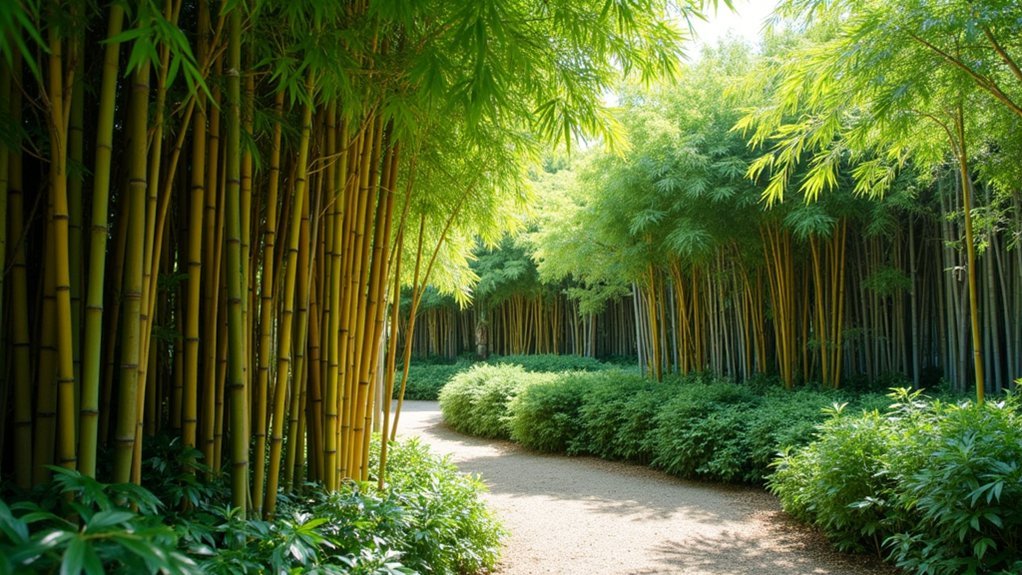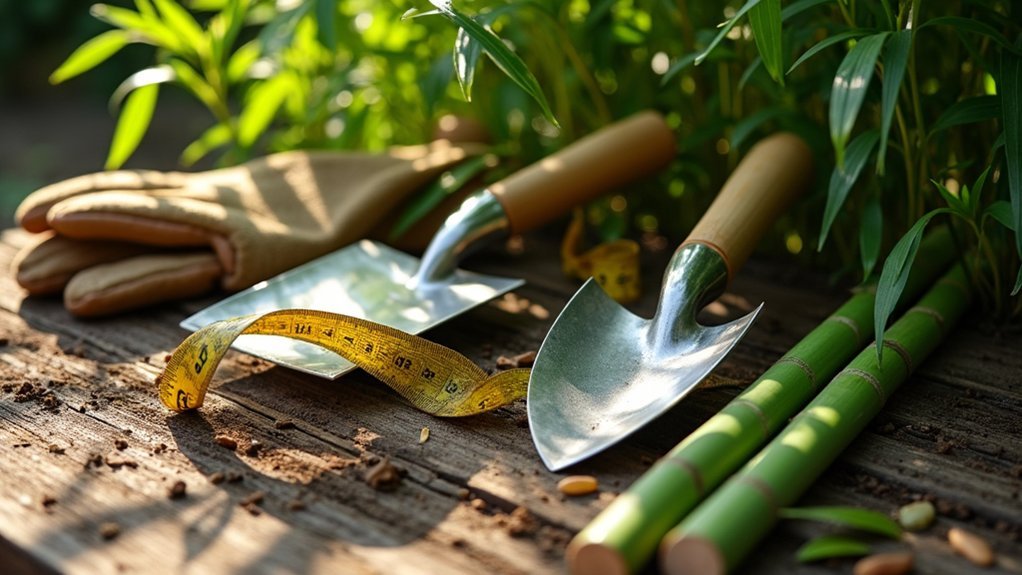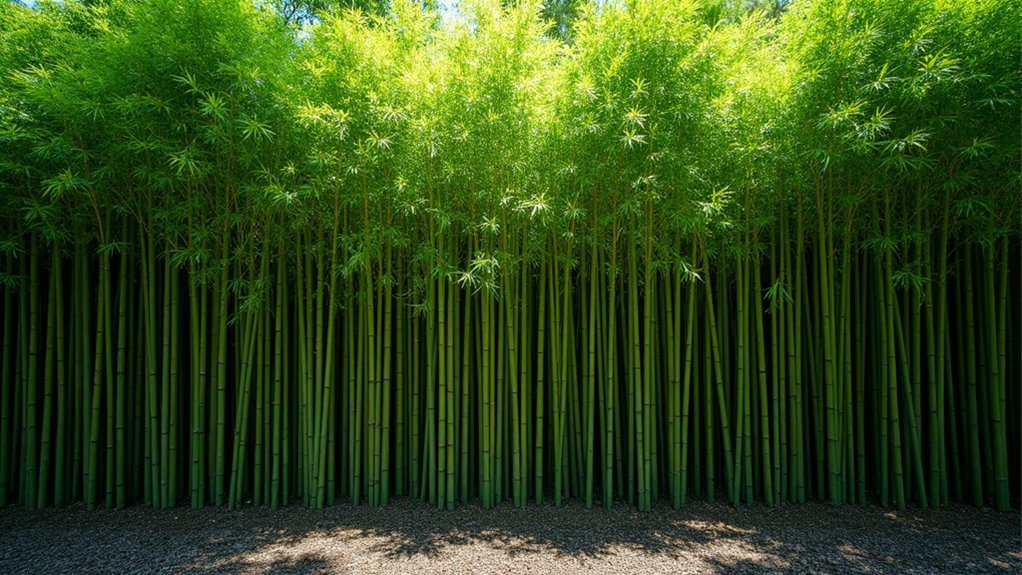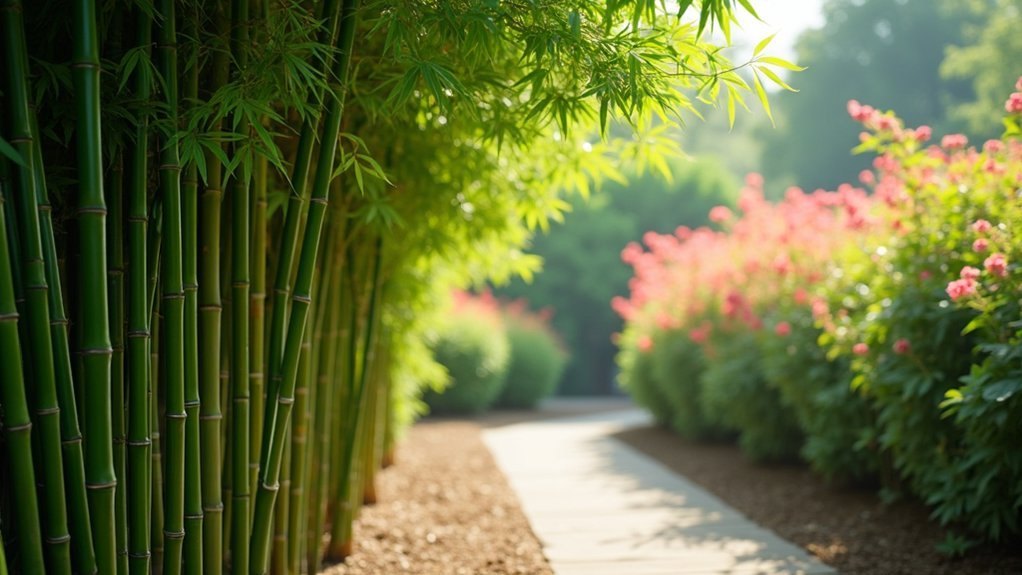To create a living bamboo fence, choose clumping varieties like Seabreeze for smaller spaces or cold-hardy species for frost-prone areas. Plant in trenches 12-28 inches deep with rhizomes spaced 3-5 feet apart, or use containers to prevent spreading. Maintain your fence with seasonal pruning, removing damaged canes in spring and protecting roots in winter. Pair with climbing vines or seasonal bloomers for visual interest. These foundational tips will transform your ordinary boundary into a thriving natural screen.
Selecting the Right Bamboo Varieties for Privacy Screens

When creating a privacy screen in your yard, the bamboo variety you select will greatly impact both functionality and aesthetics. Opt for clumping bamboo varieties like Seabreeze, Gracilis, or Slender Weavers for smaller spaces—they’re non-invasive and require less maintenance than running types.
Consider your climate carefully. Choose cold-hardy species if you experience frost, or drought-tolerant varieties like Seabreeze for drier regions. Conducting research on your area’s USDA Hardiness Zone will help ensure you select bamboo varieties that can thrive in your specific climate conditions.
For visual interest, explore bamboo with varied cane colors such as black, yellow, or spotted varieties.
Evaluate sunlight conditions in your planting area, as different bamboo species thrive in full sun to partial shade.
Most importantly, guarantee your selected variety reaches sufficient height and density to create the privacy barrier you need.
Container vs. Ground Planting: Which Method Works Best?
When planning your bamboo fence, you’ll need to choose between container or ground planting based on your specific space and needs.
Container planting offers flexibility for tight spaces like balconies and allows you to rearrange your privacy screen as needed, though it requires more consistent watering and protection from temperature extremes. Drip irrigation systems are recommended for bamboo grown in containers to ensure proper moisture levels.
Ground planting provides better stability, natural growth potential, and less maintenance overall, but requires sufficient space and possibly root barriers to prevent unwanted spreading.
Container Benefits
While both methods have their advantages, container planting offers distinct benefits for bamboo fence enthusiasts concerned about invasive growth. Containers effectively confine rhizomes, preventing unwanted spreading that often concerns property owners.
You’ll appreciate the versatility containers provide—they work wonderfully on balconies, rooftops, and tight spaces where ground planting isn’t feasible.
Larger containers maintain more consistent moisture levels, reducing both overwatering and underwatering risks.
Need to rearrange your outdoor space? Container-planted bamboo can be relocated with relative ease, giving you design flexibility. Container bamboo requires dividing every 3-4 years to ensure plants have adequate space to thrive and maintain their aesthetic appeal.
Unlike ground planting that often requires seasonal timing, you can plant bamboo in containers year-round. This flexibility lets you start your living fence project whenever inspiration strikes, rather than waiting for ideal seasonal conditions.
Ground Planting Considerations
How you prepare your planting site dramatically affects your bamboo fence’s long-term success. Dig a hole twice the diameter and 1-3 inches deeper than the root ball to give roots ample space to establish. Soften the ground by filling holes with water before placing your bamboo plants to improve initial root development. For clay or sandy soils, amend with premium garden soil and organic matter to improve fertility and drainage.
| Ground Planting | Container Planting |
|---|---|
| Unrestricted growth potential | Limited root expansion |
| Requires root spread monitoring | Prevents invasive spreading |
| Supports fuller, taller specimens | Needs periodic repotting/root pruning |
Plant bamboo at or slightly below its original container depth, then firmly press soil around roots to eliminate air pockets. Always water thoroughly after planting to reduce transplant shock. Remember that ground-planted bamboo requires vigilance—its unrestricted root system can aggressively spread if not properly contained.
Essential Tools and Materials for Bamboo Fence Installation

You’ll need specialized equipment beyond standard fence installation tools, including bamboo-specific hand tools for precise cutting and shaping of your bamboo stalks.
Root barrier systems are essential to prevent invasive bamboo species from spreading beyond your desired planting area.
When considering container planting, select containers with sufficient depth and drainage to accommodate bamboo’s extensive root system while allowing for proper growth.
Having an assistant during installation helps ensure your bamboo fence maintains a level and uniform appearance throughout the entire project.
Root Barrier Systems
Installing an effective root barrier system is the most critical step in preventing invasive bamboo from escaping your fence line.
You’ll need to create a full perimeter enclosure at least 28-30 inches deep with a 2-inch lip protruding above ground.
Choose 30 mil polypropylene sheeting for its flexibility and durability—rigid materials like concrete tend to crack under rhizome pressure. For maximum effectiveness, select barriers with high puncture resistance exceeding 4000 Newtons to prevent rhizome breakthrough.
When preparing your trench, make certain it’s wide enough to work in and check for utilities before digging. For larger projects, consider renting a mini excavator.
During installation, overlap barrier sections by 12-18 inches and secure with industrial adhesive.
Backfill carefully, compacting soil in layers.
Plan for annual inspections to catch any escaping rhizomes early, and keep glyphosate-based herbicide on hand for maintenance.
Bamboo-Specific Hand Tools
Beyond containing your bamboo’s aggressive growth habits with proper barriers, having the right tools at your disposal makes fence installation considerably more efficient. When working with bamboo’s unique properties, you’ll need specialized implements alongside standard construction tools.
| Essential Tools | Primary Purpose |
|---|---|
| Clippers | Trimming bamboo poles and cutting galvanized wire |
| Diagonal Cutter | Precise cutting of tie wire and metal components |
| Tapered Drill Bit | Creating pilot holes to prevent bamboo splitting |
| Countersink Attachment | Ensuring flush screw heads for clean finishing |
Don’t overlook the importance of protective materials like sealants and waterproofing solutions to extend your fence’s lifespan. For optimal protection and longevity, consider applying Total Wood Protector with UV inhibitors to prevent premature color fading. A cordless drill proves invaluable for on-the-spot adjustments, while galvanized wire (14-16 gauge) offers the ideal balance of strength and flexibility for securing bamboo rolls to your supporting structure.
Container Selection Essentials
Selecting the right container for bamboo fence plantings represents one of the most critical decisions in your installation process.
You’ll need minimum 15-gallon containers for standard 8-foot privacy screens, constructed from durable materials like cedar, fiberglass, or thick HDPE plastic.
Choose wide, shallow containers rather than deep ones to accommodate bamboo’s lateral root system. This configuration promotes denser foliage—exactly what you want in a privacy screen.
Always ascertain your containers have adequate drainage holes to prevent root rot, the primary killer of potted bamboo.
If you’ll need to relocate your bamboo fence occasionally, consider lighter materials, but never sacrifice durability.
Remember that container growth will limit your bamboo’s ultimate height by 30-50% compared to in-ground planting, so factor this into your privacy planning.
For contemporary outdoor spaces, select modern pots that complement your existing deck style while adding aesthetic value to your bamboo privacy screen.
Step-by-Step Trench Planting Technique for Uniform Growth

When establishing a bamboo fence, the trench planting technique offers the most reliable method for achieving uniform growth and creating a seamless privacy screen.
Dig your trench 12-28 inches deep (28″ if no root barrier is present), positioning it at least one foot from structures or fences.
Proper trench depth ensures bamboo establishment while maintaining a safe buffer from existing structures for root development.
Prepare the base with 2-3 inches of compost, then space your rhizomes 3-5 feet apart for dense screens or 15-20 feet for open groves.
Place rhizomes horizontally at their original growing depth, angling them toward the fence line to control spread direction.
Backfill in 6-inch layers, tamping each layer firmly to eliminate air pockets.
Create a slight depression at the surface to capture rainwater.
When using Fakis Arya bamboo, install a plastic barrier 2-3 feet below the soil surface to prevent runners from spreading beyond your desired area.
Apply a 2-inch mulch layer and water daily for the first 1-2 weeks.
Proper Root Barrier Installation to Prevent Unwanted Spreading
When installing bamboo fences, you’ll need to select a root barrier made of high-density polyethylene (HDPE) or heavy-duty plastic at least 60 mil thick to effectively contain spreading rhizomes.
You must dig your trench at least 28 inches deep around the entire perimeter, ensuring no sharp corners that could stress the barrier material.
Remember to leave 1-2 inches of barrier above ground level after backfilling to prevent rhizomes from growing over the top barrier edge. For additional strength and durability, consider using the 80 mil barrier which is 30% stronger than the standard 60 mil option.
Root Barrier Material Options
The right barrier material stands between successful bamboo containment and an invasive nightmare. High-density polyethylene (HDPE) offers the best combination of durability and flexibility, with a smooth surface that diverts rhizomes effectively.
Polypropylene provides similar benefits with easier on-site modification for tight spaces. For thickness, consider 40 mil as your minimum, but choose 60 mil for aggressive bamboo varieties. Both materials resist soil chemicals, UV damage, and require minimal maintenance once properly installed. Quality barriers like Bamboo Shield provide 130 pound-force puncture resistance making them highly effective against even the most aggressive rhizomes.
While concrete and metal panels work, they’re prone to cracking or difficult installation. Plastic barriers should be 24-30 inches deep to block underground rhizome spread.
Remember to select materials that allow for proper seam welding or overlap to prevent weak points where determined rhizomes might escape.
Proper Installation Depth
Selecting the right barrier material is only half the battle—proper installation depth determines whether your bamboo stays where it belongs. For most installations, dig a trench 12-24 inches deep along the entire fence line, guaranteeing your barrier extends below the typical root expansion zone.
Use a spade to create a straight, clean trench wide enough to accommodate your barrier material. Remove soil lumps to guarantee a snug fit with no gaps where roots might escape. Remember, even one small opening can allow aggressive bamboo to spread beyond your intended area.
For non-invasive clumping bamboo, a shallower barrier (around 18 inches) may suffice, but don’t skimp on depth if you’re planting running varieties.
This containment system is particularly important since bamboo grows with high tensile strength that can push through inadequate barriers over time.
Check your installation regularly and address any barrier breaches immediately to maintain effective containment.
Optimal Spacing and Arrangement for Dense Screening

Creating a dense bamboo screen requires strategic spacing and thoughtful arrangement to achieve maximum privacy. For quick coverage, plant bamboo 3-6 feet apart on-center, with smaller 1-gallon plants spaced 2-3 feet apart. Taller varieties need more room—about 2-3 meters between plants.
Consider using multiple rows for enhanced density rather than a single line. This approach creates a more effective visual barrier while allowing proper growth. Container size significantly impacts spacing requirements, with 3 gallon pots typically requiring 4-6 feet between plants.
For running bamboo, install root barriers to prevent unwanted spreading, especially near property lines. Clumping varieties need less containment but still require adequate space.
Always leave 2-4 feet of growing width and maintain clearance from structures for maintenance access.
Adjust your spacing based on growth rate, desired density, and the specific bamboo type you’ve selected.
Seasonal Care Tips to Maintain Your Living Bamboo Fence
Maintaining your living bamboo fence throughout the year requires attention to seasonal shifts and specific care routines that change with the weather.
In spring, prune damaged canes once temperatures exceed 55°F.
Summer demands increased watering and fertilization with high-nitrogen (20-5-10 NPK) products, especially during hot, windy days.
Come fall, reduce watering and apply protective sealants to prepare for winter’s challenges.
During winter, shield bamboo roots from extreme cold, and block excessive sun exposure that can cause damage.
Year-round, regularly inspect for pests, remove debris, and trim dead canes to improve airflow. Using a nylon bristle brush for gentle cleaning will help preserve bamboo’s delicate outer layer while removing accumulated dirt and debris.
Consistent maintenance vigilance keeps bamboo thriving—inspect, clean, and prune for optimal garden health.
Different bamboo types need tailored care—running varieties require containment strategies, while weeping types need more frequent pruning.
Adjust your maintenance routine based on your specific bamboo variety and local climate conditions.
Pruning Strategies to Shape and Control Your Green Barrier

Effective pruning transforms an ordinary bamboo fence into a stunning living barrier with defined shape and controlled growth. Trim culms ¼ inch above nodes to manage height while encouraging lateral growth, and remove larger-diameter shoots to maintain uniformity.
For aesthetic appeal, shear bamboo like boxwood to create dense barriers, while strategically removing congested culms to create openness. Make cuts above nodes to preserve the plant’s natural form. Implementing limb-up technique exposes elegant canes for a more sophisticated, open grove appearance.
For aesthetic appeal, shear bamboo like boxwood to create dense barriers, while strategically removing congested culms to create openness. Make cuts above nodes to preserve the plant’s natural form.
Time major pruning once yearly after spring growth, with light maintenance every 4-6 weeks during active seasons. Wait until bamboo is 2-3 years established before heavy pruning.
Use bypass pruners for smaller branches, loppers for thicker culms, and pruning saws for large-diameter stems. Keep tools sharp and wear protective gear to prevent injuries.
Solving Common Bamboo Growth Problems in Fence Applications
While bamboo fences offer striking visual appeal, they present unique challenges that can frustrate even experienced gardeners. Identifying issues early and implementing targeted solutions will save you considerable time and expense in the long run.
| Problem | Solution |
|---|---|
| Invasive rhizome spread | Install 30″ deep root barriers; check annually for escapes |
| Yellowing foliage | Adjust watering schedule; apply balanced fertilizer |
| Thin, weak growth | Increase sunlight exposure; prune overcrowded culms |
When you notice shoots appearing where they shouldn’t, act immediately by digging and removing the entire rhizome. For running bamboo varieties, consider shifting to clumping types if maintenance becomes overwhelming. Remember that proper drainage is critical—bamboo roots will rot in constantly soggy conditions, causing your fence to thin and weaken.
Enhancing Your Bamboo Fence With Complementary Plantings
A bamboo fence transforms from a simple boundary into a living focal point when paired with thoughtfully chosen companion plants.
Consider adding climbing vines like clematis or morning glory to increase privacy while introducing vibrant colors to your garden space.
For year-round interest, mix seasonal bloomers with your fence’s evergreen screening. Native species not only enhance biodiversity but typically require less maintenance, aligning with bamboo’s sustainable qualities.
Plants like marigolds can naturally repel pests that might damage your bamboo.
Create depth by layering plants of varying heights and textures around your fence.
For functionality, incorporate herbs or edibles such as strawberries along the fence line.
Add biodegradable mulch to maintain soil moisture and suppress weeds, ensuring both your fence and complementary plantings thrive together.
Frequently Asked Questions
How Quickly Will Bamboo Regrow After Severe Winter Damage?
Your bamboo will regrow gradually, with initial leaf buds appearing 2-4 weeks post-freeze. Full canopy restoration takes up to 24 months, though you’ll see new rhizome shoots by summer if the roots survived.
Can Bamboo Fences Effectively Reduce Traffic Noise?
Yes, you’ll find bamboo fences can effectively reduce traffic noise. They absorb sound rather than reflect it, especially when planted densely. For best results, you’ll need thick groves creating a natural soundscreen.
Is Bamboo Toxic to Pets or Children?
True bamboo isn’t toxic to pets or children, but be careful about “bamboo look-alikes” like Heavenly Bamboo which are toxic. Watch for chemically treated bamboo products that your pets might chew on.
How Do Bamboo Fences Affect Property Boundaries Legally?
Bamboo fences can create legal issues if they cross property lines. You’ll need barriers to control spreading, as encroachment may violate local ordinances or trigger nuisance claims from neighbors. Know your local laws before planting.
Can I Harvest My Bamboo Fence for Crafting Projects?
Yes, you can harvest bamboo from your fence for crafts. Wait until it’s at least 5 years old, cut canes close to the ground, and cure them in shade for two months before crafting.
In Summary
You’ve now got all the knowledge to create a stunning bamboo privacy screen in your yard. Remember, success comes from selecting the right variety, installing proper barriers, and maintaining consistent care. Your living fence won’t just provide privacy—it’ll become a beautiful, sustainable focal point that transforms your outdoor space. With these tips, you’ll enjoy your bamboo fence for years to come.





Leave a Reply